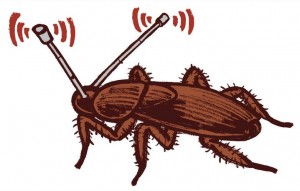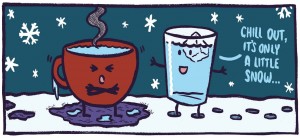TUESDAY, 4 FEBRUARY 2014
Help, I need a cockroach!Remote-controlled cockroaches might sound like a cartoon super-villain plan, but far-fetched as it seems, the technology is real. Developed by a team at North Carolina State University, it uses motion-sensing Microsoft Kinect system, originally developed for Xbox. So what’s the purpose behind these cyborg cockroaches? Well, other than trying to freak out your grandmother or make the first invertebrate chorus line, the researchers hope to use them to map unknown environments where GPS technology cannot be used, such as collapsed buildings. Cockroaches are ideal for this because their movement is essentially random. The wired-up cockroaches (known as biobots) would be let loose at the scene, and allowed to wander. Radio- signals would be sent to the researchers every time two biobots got close to each other. By commanding them to find and follow walls, go back to random movement, and repeat, an algorithm can be used to translate the biobot data into a rough map of the environment. Chemical and radiation sensors could also be attached to help inform of possible hazards. Who knows? Biobots could soon become the next emergency service. Nathan Smith
The Mpemba effect
Hot water freezes faster than cold water. Although this phenomenon has been observed for centuries, researchers have finally explained why. The so-called “Mpemba effect” was first described by Aristotle in the 4th century BC, and later by Francis Bacon and Rene Descartes. It is named after the Tanzanian student, Erasto Mpemba who, in 1969, published the observation that ice cream mix freezes faster when it’s warm. Why this phenomenon occurs has long been a conundrum but recent work from Xi Zhang’s team at the Nanyang Technological University in Singapore seems to suggest the secret lies in the water’s molecular interactions. Each water molecule is formed by two atoms of hydrogen and one of oxygen united via strong covalent bonds. Water molecules interact with each other via weak attractive forces called hydrogen bonds. Zhang’s idea is that hydrogen bonds generate repulsive forces between water molecules by pulling them close together. This stretches the covalent bonds between atoms and makes them store energy. As water warms up, the hydrogen bonds loosen up, allowing the covalent bonds to shrink and release the stored energy—a process equivalent to cooling. When warm water is exposed to freezing temperatures, this extra cooling mechanism acts in addition to the conventional one, causing a faster rate of freezing. Ornela De Gasperin Quintero
Left wag, right wag
A new study from two Italian universities indicates dogs can tell the difference between left and right. It has long been known that the direction of a tail wag can provide important information, with rightward saying “come and play”, and leftward warning “I want to bite you”. However, whether or not such gestures are used for communication between our canine friends was not shown until last November. Scientists measured the heart rates of 43 pooches in response to wagging video clips, and found that they were significantly higher for leftward wags. This indicates an ability to detect aggression from tail wag direction alone. The implications of this research go beyond making it that little bit more embarrassing if you are someone who confuses left and right, as it provides supporting evidence for the fundamental asymmetry of canine brains. The left side, which instructs muscles on the right, is thought to be more associated with “approach” behaviours, while the right controls the left side of the body and is linked to “withdrawal”. The extension of this theory to behaviours triggered by social cues, such as exhibiting stress reactions when watching a nasty leftwagger, seems to suggest that the need for communication played an important role in the evolution of brain lateralisation. Elly Smith


